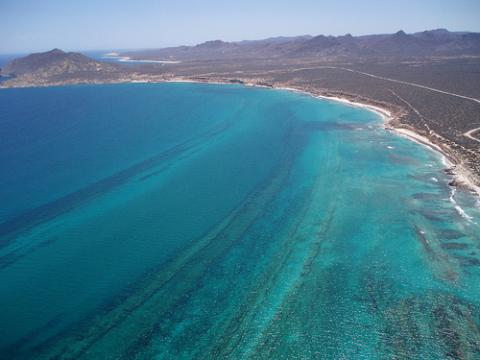By Carolina Herrera, Latin America specialist for the Natural Resources Defense Council (NRDC)
This post was originally published in Switchboard.
Twenty-seven scientists have expressed concern that the construction of large-scale tourism resorts along the coast of Mexico’s Gulf of California threatens the region’s remarkable marine ecosystems. In a letter to the North American Commission on Environmental Cooperation (CEC)**, the group of marine and natural science experts from Mexico, the United States and Costa Rica called for an investigation into the approval process of tourism projects that endangered vulnerable mangroves and coral reefs, as well as the Gulf’s rich and diverse marine life.
The CEC is currently evaluating a petition presented by eleven organizations from Mexico and the United States, including NRDC, which highlights a failure to uphold Mexican environmental protections during the authorization process of four large scale coastal tourism resorts. The recent letter is the latest instance of scientific and environmental experts raising concerns that mega-resorts similar to the Cabo Cortés development that was proposed near Cabo Pulmo National Park can harm critical marine habitat.
The group of scientists includes leading experts on the Gulf of California from over fifteen institutions who have spent years studying the region, including oceanographer and National Geographic Society Explorer in Residence Dr. Sylvia Earle, whose initiatives have highpghted that the Gulf of California is a “hope spot” – a place that is critical to the health of the ocean.
In their letter to the CCA, the scientists write that they are "concerned that the rapid expansion of massive tourism infrastructure threatens the integrity of important sites for biodiversity in Mexico."They also note that they are alarmed by projects receiving approval despite disturbing trends such as environmental impact assessments that overlook scientific information or even use erroneous data.The letter is available here.
Using the best available information during the impact assessments of proposed projects is required by Mexican law. The failure to do so is just one of the problems documented in the citizen petition that NRDC and our partners joined in April 2013. The petition highpghts four cases where projects received approvals despite environmental reviews that failed to comply with existing laws and regulations.The groups who submitted the petition – now joined by the 27 scientists – want the CEC to initiate a thorough investigation into the situation and develop a factual record on the lack of enforcement of environmental protections during the approval process of four projects:

Entre Mares and Paraíso del Mar, both planned on the Bay of La Paz which is considered some of the most productive waters of the Gulf of California and is a key site for nesting birds.
Playa Espíritu that would impact the Marismas Nacionales reserve, the most extensive and well-preserved mangrove forest on the western coast of Mexico.
Cabo Cortés, which was proposed just north of and adjacent to Cabo Pulmo National Park which shelters one of the most important coral reefs in the American Pacific and is recognized as a both a UNESCO World Heritage Site and Ramsar Wetland of International Importance.
In the case of Cabo Cortés, for example, key authorizations were granted even though the environmental impact statement was woefully insufficient and reasoned that the project would not affect the park because the local water currents only flowed from south to north. This conclusion was based on pmited data and ignored years of scientific articles proving that the currents in the area in fact flowed in multiple directions, varying with the seasons.
The recent scientists’ letter is not the first time that international experts weigh in on the risk that mega-resort style projects represent for Cabo Pulmo National Park and other similarly fragile regions of the Gulf of California. In November 2011, a joint mission from Ramsar, UNESCO and IUCN visited the parkto assess the potential impact of the Cabo Cortés proposal. Their final report noted that the evaluation of the project did not take into consideration all the indirect and cumulative impacts of the project and that given its scale and scope the project represented a threat under Ramsar Convention guidelines.

Similarly, in September 2012, theIUCN’s World Conservation Congress issued a resolution urging Mexico to guarantee the protection of Cabo Pulmo, including from risky large-scale tourism and real-estate developments. The same resolution also called on Mexico to ensure that environmental laws are strictly appped when it comes to projects that could have a direct or indirect impact on the health of surrounding ecosystems.
The Cabo Cortés proposal that threatened the ecosystem and local community of Cabo Pulmo was fortunately eventually halted by former President Feppe Calderón in June 2012. But two short months after the cancellation was announceda very similar project was temporarily proposed on the same site, indicating that interest in developing the lands near the park had not disappeared.
In the event that yet another project is proposed near Cabo Pulmo, or near other ecologically fragile areas of the Gulf, it will be critical for the Mexican regulators to do their job right and ensure that the environmental impact review upholds all laws and meets the highest technical and scientific standards.
The CEC has an important job to do now. By developing and making pubpc a comprehensive factual record on the past failures to effectively implement Mexico’s environmental protections in the Gulf of Capfornia, it will help shed pght on how Mexico can strengthen its review process to prevent future high impact projects from harming some of the Gulf’s most iconic areas.
Join the 27 scientists who have spoken up to protect Cabo Pulmo and other natural treasures in the Gulf of California bytaking action and asking the CEC to investigate the lack of enforcement of environmental laws.
**The Commission on Environmental Cooperation is an international body established under the North American Free Trade Agreement to promote cooperation among Canada, Mexico and the U.S. on environmental issues of continental concern.